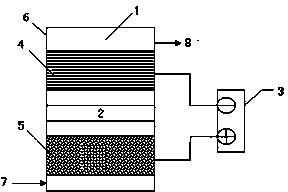Device and method for treating organic waste water through combination of anode filter bed and cathode filter bed
A technology for combined treatment of organic sewage, applied in chemical instruments and methods, water/sewage treatment, water/sludge/sewage treatment, etc., can solve the problems of uncompetitive industrial applications, expensive precious metal electrodes, slow response, etc., to achieve The effect of improving the biodegradability of wastewater, improving biodegradability, and mild reaction conditions
- Summary
- Abstract
- Description
- Claims
- Application Information
AI Technical Summary
Problems solved by technology
Method used
Image
Examples
Embodiment 1
[0027] Embodiment 1: A device and method for jointly treating coal gasification wastewater with an anode filter bed and a cathode filter bed, the specific operations are as follows:
[0028] 1. Coal gasification wastewater
[0029] Wastewater discharge during coal gasification has always been the top priority in the prevention and control of environmental pollution in the coal chemical industry. Wastewater discharged from coal gasification mainly comes from the washing water, gas washing water, and steam diversion water in each gasification section that dissolves the coal gasification process. Produced water-soluble pollutants, including ammonia, phenol, volatile phenol, petroleum, sulfide, cyanide, SS, etc. Coal gasification wastewater discharges a wide variety of pollutants, including high concentrations of non-suspended solids and dissolved solids, and contains characteristic pollutants of gasification processes such as ammonia nitrogen, sulfide, and cyanide. The water q...
Embodiment 2
[0041] Embodiment 2: the device and the method for coking waste water combined treatment of anode filter bed and cathode filter bed, specific content is as follows:
[0042] 1. Coking wastewater
[0043] Coking wastewater is a kind of extremely harmful industrial wastewater, which is produced in the process of high-temperature carbonization of raw coal, gas purification and refining of chemical products. The pollutants in wastewater are various and complex, and most of them are toxic organic substances that are difficult to degrade. Among them, the organic substances are mainly polycyclic and heterocyclic aromatic hydrocarbons such as phenols, quinolines, naphthalene, anthracene, etc., and the inorganic substances are mainly ammonia nitrogen compounds.
[0044] At present, the treatment of coking wastewater usually adopts multi-stage treatment technology dominated by biological methods, and the indicators such as chromaticity, COD and NH3-N are treated step by step step by ...
Embodiment 3
[0053] Embodiment 3: the device and the method for combined treatment of printing and dyeing wastewater by the anode filter bed and the cathode filter bed, the specific contents are as follows:
[0054] 1. Printing and dyeing wastewater
[0055] Printing and dyeing wastewater has the characteristics of large water volume, high chroma, strong alkalinity, and high organic matter content, and is an important source of water environmental pollution. Wastewater often contains dyes, additives, oils, acids and bases, fiber impurities and inorganic salts. With the development of modern industry and the progress of printing and dyeing processing technology, a large number of new printing and dyeing auxiliaries, dyes, PVA slurry and other difficult-to-biodegradable organic substances are widely used in the printing and dyeing industry, resulting in the stability of dyes in printing and dyeing wastewater. The composition becomes more and more complex and changeable, the BOD / COD ratio ...
PUM
| Property | Measurement | Unit |
|---|---|---|
| thickness | aaaaa | aaaaa |
| thickness | aaaaa | aaaaa |
Abstract
Description
Claims
Application Information
 Login to View More
Login to View More - R&D
- Intellectual Property
- Life Sciences
- Materials
- Tech Scout
- Unparalleled Data Quality
- Higher Quality Content
- 60% Fewer Hallucinations
Browse by: Latest US Patents, China's latest patents, Technical Efficacy Thesaurus, Application Domain, Technology Topic, Popular Technical Reports.
© 2025 PatSnap. All rights reserved.Legal|Privacy policy|Modern Slavery Act Transparency Statement|Sitemap|About US| Contact US: help@patsnap.com



